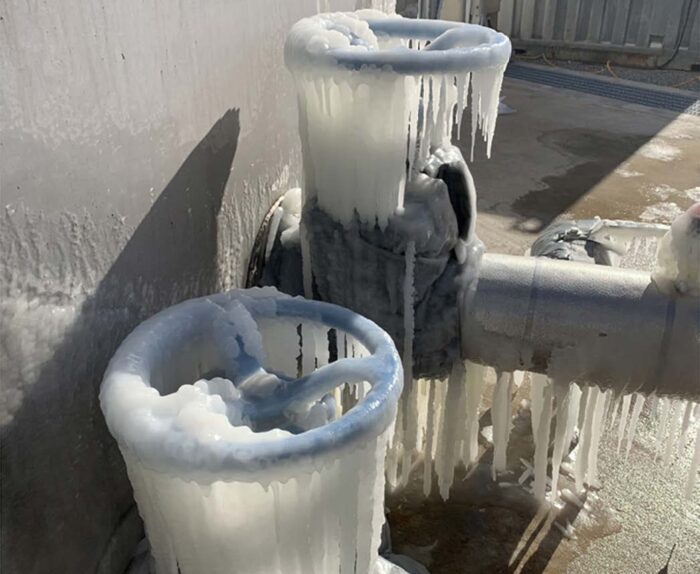Solar shone when fossil fuels failed last Christmas
Last Christmas Eve, as North Carolinians prepared to celebrate the holiday season, Winter Storm Elliott blew in, causing temperatures outside to plummet. But instead of staying toasty indoors, 500,000 Carolina households lost power. The sudden cold weather created gas shortages and caused pipes and other critical equipment at gas and coal plants to malfunction, forcing regulated monopoly Duke Energy to implement rolling energy blackouts across the state.
I didn’t want to sit in the house and freeze.
Durham resident Vanessa Taylor
Vanessa Taylor, who lives in Durham, was about to cook green beans for a Christmas feast when her power cut out at around ten in the morning. Taylor headed to her daughter’s home, driving through intersections where traffic lights were out. “Being older, I didn’t want to sit in the house and freeze,” she said. Taylor’s power wouldn’t return until after dark.
Greensboro artist Caroline Armijo lost power for four hours and said it took days to bring her 1920s-era home back to comfortable temperatures. She remembered feeling shocked that the grid had failed so easily. “It had been less than 24 hours since the cold snap,” she said. “It was unbelievable that the grid didn’t hold.”

That extreme vulnerability may have seemed unbelievable, but gas-related power failures are becoming disturbingly common, according to the Federal Energy Regulatory Commission. One year after Winter Storm Elliott, clean energy advocates said that the blackouts highlighted the persistent precarity of a grid reliant on fossil fuels – and the urgent need to transition toward cleaner, more reliable energy sources.
What went wrong?
Duke Energy confirmed after last year’s blackouts that the grid failures were largely related to fossil fuel generation. The need for heat drove up demand for gas, causing shortages, while gas and coal infrastructure experienced mechanical issues in the cold.
Meanwhile, renewable energy sources performed as expected, with solar supplying additional power during the storm by recharging pumped hydro storage. As climate change brings more frequent extreme weather events, renewables provide reliability: solar paired with storage – particularly long duration storage – can provide energy even when the sun isn’t shining, and offshore wind generally performs best on windy, wintry mornings.
“North Carolinians deserve power that remains reliable when they need it the most,” said Mary Maclean Asbill, director of SELC’s North Carolina offices. “If our grid had more solar, wind, and storage available last winter, Duke could have avoided blackouts.”

Across other gas-reliant southern states, Christmas eve blackouts were common. In South Carolina, almost 95,000 households lost power. And in Tennessee, where federal utility TVA derives only four percent of its power from solar and wind, over 300,000 customers experienced blackouts.
In its recent report on Winter Storm Elliott, FERC called the regional grid disaster “unacceptably familiar.” Elliott was the fifth event in the last 11 years in which America’s grid experienced widespread, gas-related failures during extreme weather. Equally concerning is data that showed the majority of last year’s grid failures occurred while above utilities’ documented operating temperatures – meaning a colder, longer storm could have even more severe impacts.
That lack of reliability is deeply troubling as we head into another winter, but Asbill said that solutions could also be within reach.
“The North Carolina Carbon Plan is a critical opportunity to achieve energy reliability,” she said. “It’s a chance to rapidly phase out fossil fuels and significantly build out clean energy.”
Achieving reliability through the Carbon Plan
The Carbon Plan was established through bipartisan legislation in 2021. It tasks the North Carolina utilities commission with approving a plan to reduce climate-warming carbon pollution by 70 percent by 2030. An initial version of the plan was approved in 2022, and the utilities commission will authorize the next version in late 2024.
But in August, Duke Energy proposed a plan that would double down on building new gas plants. Duke’s plan would delay the state’s carbon emissions reduction deadline by years and lock North Carolinians into decades of further fossil fuel use.
North Carolinians shouldn’t pay the price for Duke’s misguided devotion to the same polluting energy source that knocked the power out last year.
Mary Maclean Asbill, North Carolina Office Director
Clean energy advocates said that gas doesn’t just pose reliability issues– it has dangerous implications for climate and affordability goals. Methane, the primary component of gas, is responsible for nearly a third of global warming, heating our atmosphere at 27-30 times the rate of carbon pollution over a 100-year period. Gas is also subject to rapid spikes in price due to global shortages: when that happens, customers, not utilities, foot the bill. Unfortunately, utilities across our region have continued to invest in new gas, even as the pollutant harms its customers.
For Armijo, utilities’ notion that gas is a “bridge fuel” to a clean energy future rankles. “They built a terrible bridge,” she said. “It has holes in it!” She added that the power sector, as the second largest contributor to climate-changing pollution, has a responsibility to protect customers from extreme weather events. “Utilities got us into this situation and are doing nothing to prevent us from physically suffering,” she said.
With the holiday season here again, and Winter Storm Elliott still fresh in the minds of many residents, Asbill said, “It’s crucial that we raise our voices for a meaningful and timely energy transition. North Carolinians shouldn’t pay the price for Duke’s misguided devotion to the same polluting energy source that knocked the power out last year.”
In the next few months, SELC will release its Carbon Plan for the utility commission’s review.
